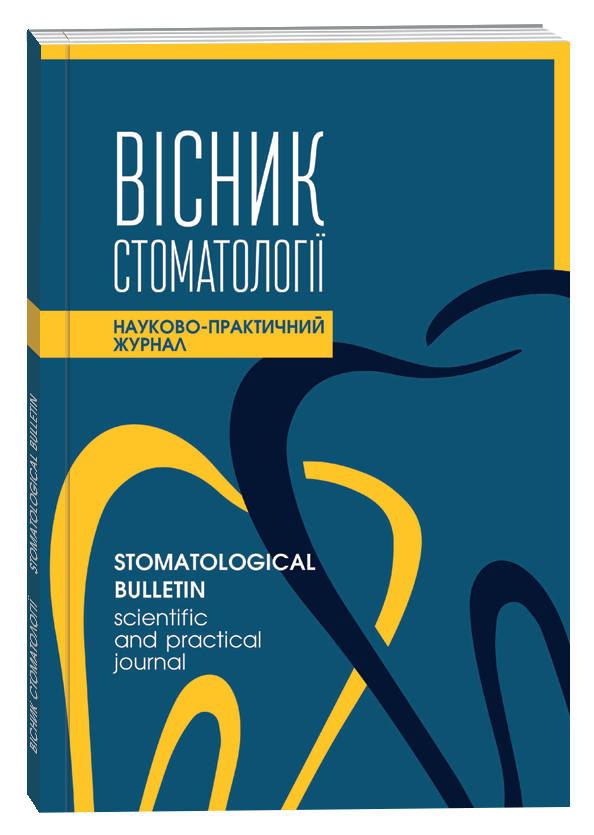PALPATORY DETERMINATION OF TRIGGER ZONES OF CHEWING MUSCLES IN MYOFASCIAL PAIN SYNDROME
DOI:
https://doi.org/10.35220/2078-8916-2020-35-1-79-86Keywords:
muscle spasm, chewing muscles, occlusion disorders, myofascial face pain syndrome, palpation trig-ger pointsAbstract
Muscle spasm results from excessive stretching, pro-longed contraction, or muscle fatigue and forms the basis of myofascial facial pain syndrome (MFPS). In the first stage, residual tension occurs in the muscle, followed by stable local hypertonus. Local hypertensives become a source of local and reflected pain and turn into trigger points (TP). On the face of the TP are found more often in the chewing muscles, temporal, lateral and medial pterygoid muscles. The main method of detection of trig-ger points in clinical practice, as in the diagnosis of myofascial pain syndrome in general, is palpation of the chewing muscles. 45 patients (8 men and 37 women) were examined for the clinical definition of painful muscular seals (PMS) and myofascial trigger points (MTP) in chewing muscles on the background of occlusive dysfunction in facial pain syndrome. The MFPSs were characterized by a constant, persistent, day-long, monotonous pain, aching, squeezing, pulling character. The presence of trigger zones was de-termined by palpation according to the method of Simons D.G., Travel J.G., Simons L.S. (1999) and consisted of de-termining the presence of pain areas of spasmodic muscle or painful muscle seals (PMS). These PMSs were desig-nated as a critical point (TP) or myofascial critical point (MCP). As a result, it was found that the duration of the disease ranged from 6 months to 5 years. The occurrence of pain after the visit of the dentist was noted by 24 (53 %) pa-tients, of whom: in 13 (54 %) patients the pain appeared after prosthetics, in 4 (17 %) - after tooth extraction, in 7 (29 %) patients - after dentistry. 11 (24 %) patients asso-ciated the development of pain syndrome with TMJ pa-thology, 3 (8 %) - with trigeminal lesions, 4 (10 %) - with emotional stress and 2 (5 %) with trauma. Palpation of the muscles on the pain side drew attention to the dense consistency and tension of the muscles, especially chew-ing and mimetic, as well as their expressed tenderness. In these muscles, many active MCPs were palpated, irrita-tion of which allowed to reproduce the pain complained of by patients. Palpation of the muscles of the opposite side was painless or moderately painful. Also found pain-less seals (latent MCP), irritation of which caused mod-erate pain without irradiation. Palpation of the muscles that lower the lower jaw (maxillo-sublingual, two- ab-dominal muscles) was less painful in all patients. During their palpation, the pain radiated into the tongue, throat, neck. Occlusive disorders not only contribute to the onset of pain, but also significantly complicate its course. It should be noted the high frequency of development of MFPS after dental prosthetics, when the function of chew-ing muscles does not have time to adapt to unusual occlu-sion. Changes in occlusion can cause minimal abnormali-ties in the TMJ and can lead to degenerative changes in one or both joints.
References
Simons DG, Travell JG, Simons LS. Travell and Si-mons' myofascial pain and dysfunction; the trigger point manu-al. 2 ed. Baltimore: Williams & Wilkins; 1999.
Simons DG. Review of enigmatic MTrPs as a common cause of enigmatic musculoskeletal pain and dysfunction. J.Electromyogr Kinesiol 2004;in press.
Janda V. Muscle spasm: a proposed procedure for dif-ferential diagnosis. J Manual Med 1991;6:136-13.
Harden RN, Bruehl SP, Gass S, Niemiec C, Barbick B. Signs and symptoms of the myofascial pain syndrome: a na-tional survey of pain management providers. Clin J Pain 2000;16(1):64-72.








